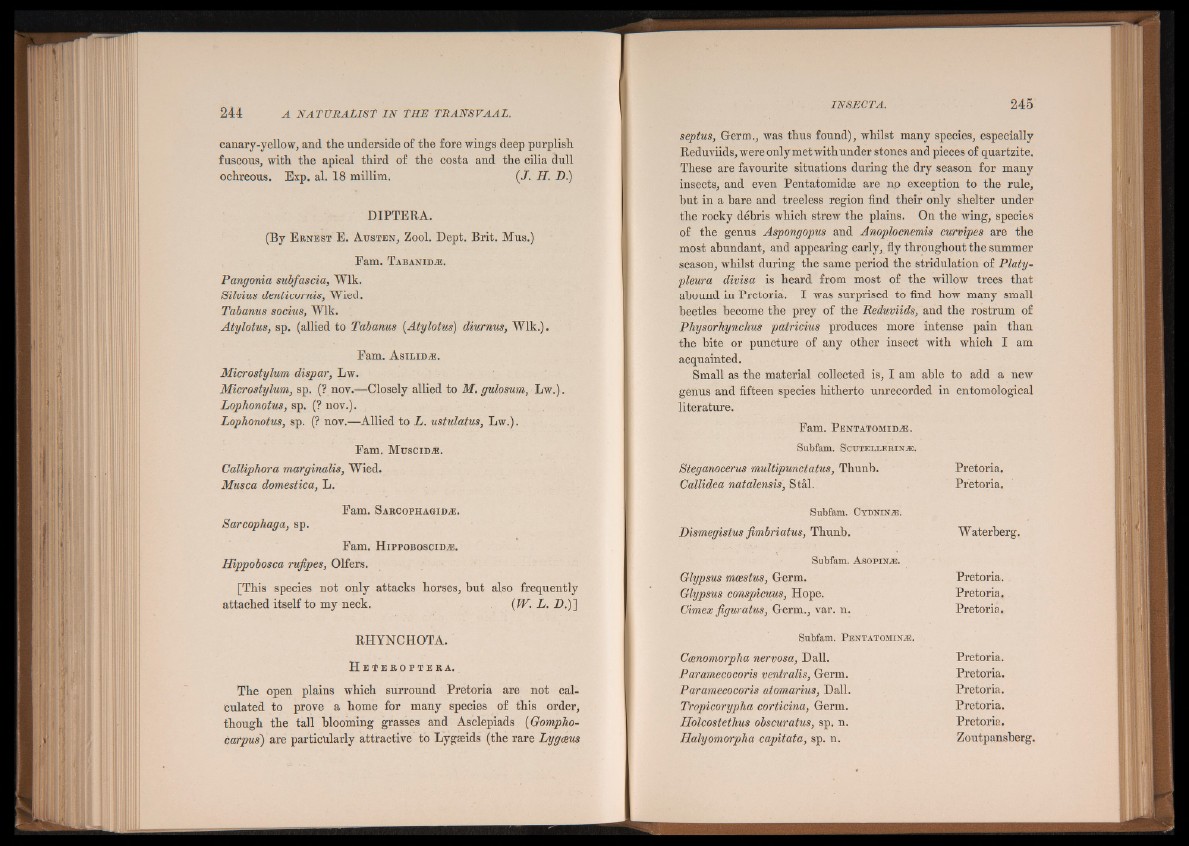
canary-yellow, and the underside of the fore wings deep purplish
fuscous, with the apical third of the costa and the cilia dull
ochreous. Exp. al. 18 millim. (/. H. D.)
DIPTERA.
(By E r n e s t E. A ttsten, Zool. Dept. Brit. Mus.)
Earn. T a b a n id jE.
Pangonia subfascia, Wlk.
Silvius denticornis, Wied.
Tabanus socius, Wlk.
Atylotus, sp. (allied to Tabanus (Atylotus) diurnus, Wlk.).
Earn. AsilidjE.
Microstylum dispar, Lw.
Microstylum, sp. (? nov.— Closely allied to M. gulosum, Lw.).
Lophonotus, sp. (? nov.).
Lophonotus, sp. (? nov.—Allied to L. ustulatus, Lw.).
Fam. MusciDsE.
Calliphora marginalis, Wied.
Musca domestica, L.
Fam. S a r c o ph a g id jE.
Sarcophaga, sp.
Fam. H ip p o b o s c ib .®.
Hippobosca rufipes, Olfers.
[This species not only attacks horses, but also frequently
attached itself to my neck. {W. L. Z).)]
RHYNCHOTA.
H e t e r o p t e r a .
The open plains which surround Pretoria are not calculated
to prove a home for many species of this order,
though the tall blooming grasses and Asclepiads (Gompho-
carpus) are particularly attractive to Lygseids (the rare Lygceus
septus, Germ., was thus found), whilst many species, especially
Reduviids, were only met with under stones and pieces of quartzite.
These are favourite situations during the dry season for many
insects, and even Pentatomidse are np exception to the rule,
but in a bare and treeless region find their only shelter under
the rocky debris which strew the plains. On the wing, species
of the genus Aspongopus and Anoplocnemis curvipes are the
most abundant, and appearing early, fly throughout the summer
season, whilst during the same period the stridulation of Platy-
pleura divisa is heard from most of the willow trees that
abound in Pretoria. I was surprised to find how many small
beetles become the prey of the Reduviids, and the rostrum of
Physorhynchus patricius produces more intense pain than
the bite or puncture of any other insect with which I am
acquainted.
Small as the material collected is, I am able to add a new
genus and fifteen species hitherto unrecorded in entomological
literature.
Fam. P e n t a t o m id s e .
Subfam. Scutelleejna!.
Steganocerus multipunctatus, Thunb.
Callidea natalensis, Stal.
Subfam. Cydninye.
Dismegistus fimbriatus, Thunb.
Subfam. Asopina.
Glypsus mcestus, Germ.
Glypsus conspicuus, Hope.
Cimex figuratus, Germ., var. n.
Subfam. Pentatomina.
Ccenomorpha nervosa, Dali.
Paramecocoris ventralis, Germ.
Paramecocoris atomarius, Dali.
Tropicorypha corticina, Germ.
Holcostethus obscuratus, sp. n.
Halyomorpha capitata, sp. n.
Pretoria.
Pretoria.
Waterberg.
Pretoria.
Pretoria.
Pretoria.
Pretoria.
Pretoria.
Pretoria.
Pretoria.
Pretoria.
Zoutpansberg.